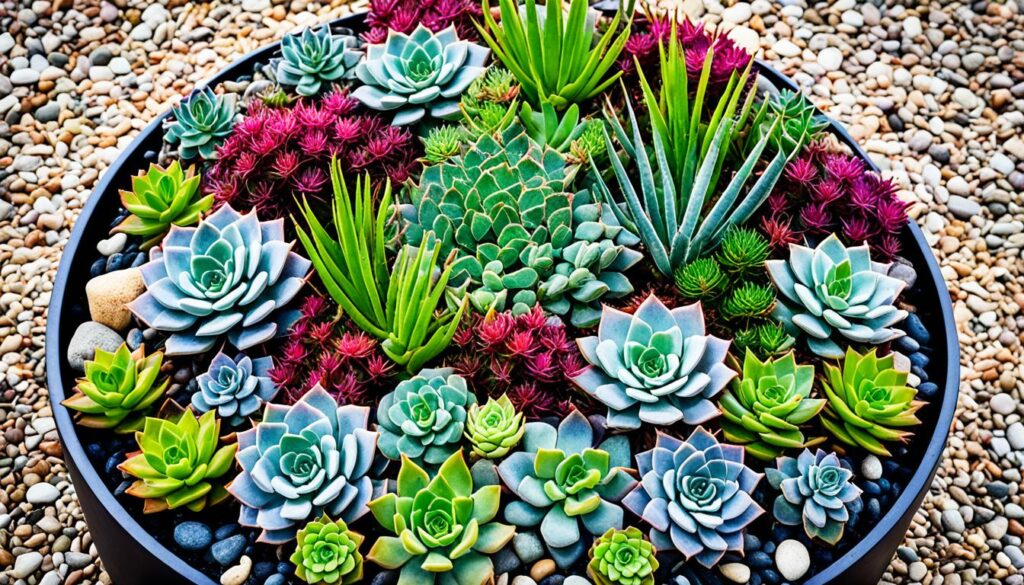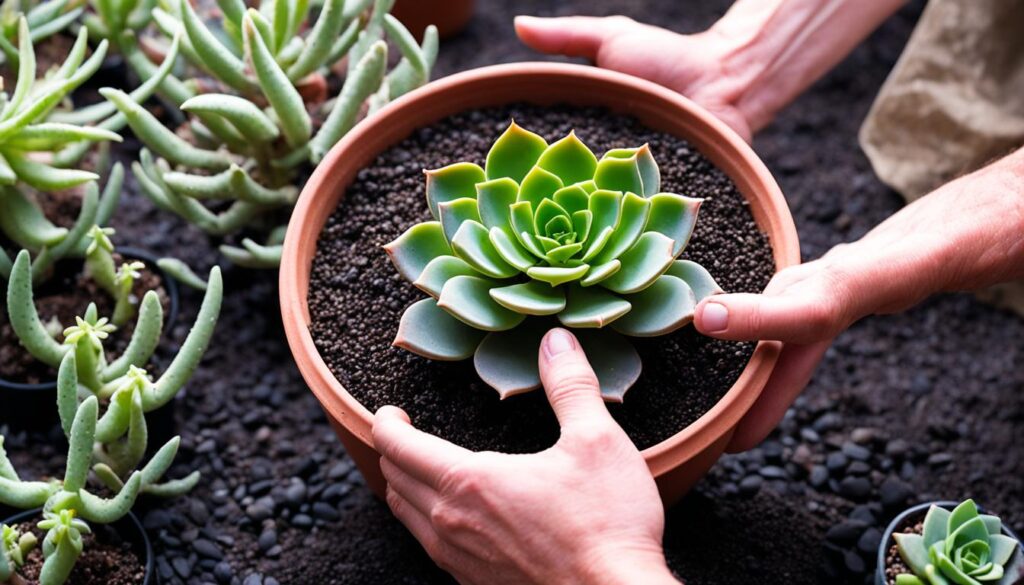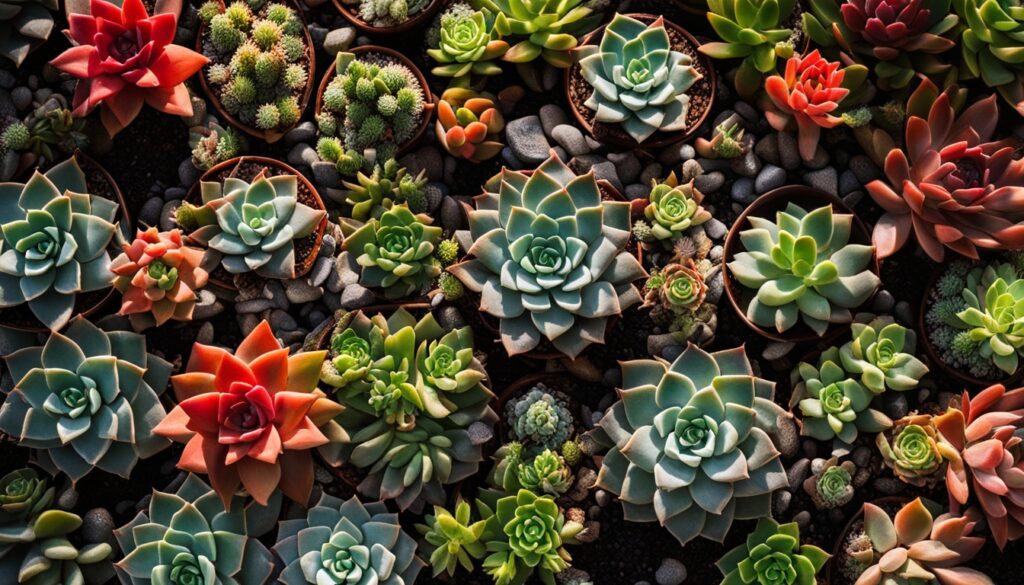Create a Beautiful Succulent Garden: Simple Steps
Creating a beautiful garden doesn’t have to be hard or expensive. With succulents, you can have a garden that’s easy to maintain and looks great. These plants store water, so they need little care. They’re perfect for anyone who wants a beautiful garden without the hassle.
Planting succulents is simple. They’re tough and can survive with little water. You only need to water them once every week or two. So, get your trowel, gloves, and sunscreen ready. It’s time to start your own succulent garden.
Key Takeaways
- Succulents are low-maintenance, drought-tolerant plants that can thrive with minimal care.
- Creating a succulent garden is an easy and effortless way to enhance your outdoor space.
- Proper soil, watering, and light requirements are essential for the health and growth of succulents.
- Succulents come in a wide variety of shapes, sizes, and colors, allowing for a diverse and visually appealing garden.
- Succulents are a great choice for beginner gardeners or those looking for a low-maintenance landscaping option.
Introduction
Succulents are fascinating plants that have become very popular lately. They come in many shapes, sizes, and colors. This makes them perfect for those wanting to learn about succulent care or how to care for cacti. They are great for both experienced and new gardeners. Adding drought-tolerant plants to your outdoor gardening, low-maintenance landscaping, or container gardening can be fun and rewarding.
This guide will explore the world of succulents. We’ll look at their unique traits, best growing conditions, and how to keep them thriving. By the end, you’ll know a lot about these plants and how to make a beautiful, easy-care garden.
Succulents store water in their leaves, stems, and roots. This makes them tough and able to live in many climates. They come in many shapes, from simple rosettes to complex designs. Many also have beautiful flowers that add to their appeal.
“Succulents are the perfect plants for those who have a passion for gardening but don’t have much time to devote to it. They thrive on neglect and require minimal care, making them an ideal choice for busy individuals or those new to the world of plant parenting.”
Succulents are great for creating a low-maintenance landscaping or a striking container gardening setup. They can grow well in many conditions. These drought-tolerant plants add beauty to any space, indoors or outdoors. They’re a favorite among those who enjoy succulent care and how to care for cacti.
Choosing the Right Plants
Choosing the right plants is key to a beautiful and thriving succulent garden. Succulents vary in shape, size, and color, each with unique care needs. It’s vital to know what each plant requires before you start.
Think about how much sun your garden gets when picking succulents. Some, like snake plants and jade plants, do well in shade. Others, such as aloe, aeoniums, and agave, love full sun. Knowing your garden’s sun levels helps pick the right drought-tolerant plants for your space.
Also, consider the soil needs of succulents. They like soil that drains well to prevent root rot. Heavy soils can harm them. Use a cactus or succulent potting mix, or mix sand, perlite, and compost yourself.
| Succulent Type | Sun Exposure | Soil Preference |
|---|---|---|
| Snake Plant | Partial Shade to Full Sun | Well-draining |
| Jade Plant | Partial Shade to Full Sun | Well-draining |
| Aloe Vera | Full Sun | Well-draining |
| Aeonium | Full Sun | Well-draining |
| Agave | Full Sun | Well-draining |
By picking the right plants for your succulent garden, you’re on your way to a thriving garden. With proper care, your succulents will flourish for years.

Potting and Soil
Creating a thriving succulent garden starts with the right potting soil. Succulents need soil that drains well to prevent root rot. This is because they can’t handle too much moisture.
For your succulents to do well, mix organic matter like compost with materials that help with drainage. Think about adding sand, grit, pumice, perlite, small gravel, or crushed granite. This mix gives them the nutrients they need and ensures good drainage.
Transplanting succulents can be tricky, but they’re tough plants. Even if roots get damaged or the plant moves around, they usually recover fast. With the right soil for succulents and some care, you can make a beautiful succulent garden indoors or outside.
“The key to success with succulents is understanding their soil needs. By creating a well-draining mix, you’ll set them up for long-term succulent care and vibrant growth.”
When potting your succulents, use containers with drainage holes. This stops water from building up and harming the plants. Whether you’re gardening outdoors or in containers, the right soil and potting methods are key to a beautiful, easy-to-care-for succulent garden.

Watering Guidelines
Watering your succulent garden right is key. Too much water can hurt them just like too little. Succulent and cactus plants don’t like wet soil because it can cause root rot. So, water them deeply but not too often.
Start by waiting a day or two after planting before you water your outdoor gardening or container gardening succulents. This lets their roots heal and get used to their new spot. Then, check the soil by sticking your finger into the top layer. If it’s dry, it’s time to water. If it’s still damp, wait a bit longer.
- Water your succulents deeply, letting the soil soak up the moisture.
- Wait until the soil is dry before watering again, usually every week or two.
- Don’t keep the soil wet all the time, as this can cause watering succulents problems like root rot.
It’s safer to underwater your succulent care plants than to overwater them. Dry soil is easier for them to bounce back from than root rot. By following these watering guidelines, you’ll help your succulent garden thrive.
“Watering succulents is an art, not a science. Err on the side of too little water rather than too much.”
Light and Temperature Requirements
Light and temperature are key for a healthy succulent and cactus garden. Whether you’re growing drought-tolerant plants inside or outside, knowing what they need is vital. This knowledge helps with their care and upkeep.
Succulents need a lot of sunlight, but some like a little shade. For example, snake plants and jade plants do well in the shade. On the other hand, aloe, aeoniums, and agave love the sun.
Succulents can handle different temperatures. The soft ones prefer warm weather above 50 degrees Fahrenheit. They can’t stand the cold. But, some like hens and chicks, stonecrop, and hardy yellow ice plant can get as cold as -20 degrees Fahrenheit.
Knowing what your succulents need for light and temperature lets you create the best conditions. This is true whether you’re tending to a container garden or an outdoor one. It ensures these plants thrive with little effort.

| Succulent Type | Lighting Needs | Temperature Tolerance |
|---|---|---|
| Snake Plant | Partial Shade | 50°F – 90°F |
| Jade Plant | Partial Shade | 50°F – 80°F |
| Aloe Vera | Full Sun | 55°F – 85°F |
| Aeonium | Full Sun | 50°F – 75°F |
| Agave | Full Sun | 40°F – 110°F |
| Hens and Chicks | Full Sun | 40°F – -20°F |
| Stonecrop | Full Sun | 40°F – -20°F |
| Hardy Yellow Ice Plant | Full Sun | 40°F – -20°F |
Feeding and Fertilizing
Caring for your succulent plants means paying attention to their diet and nutrients. Succulents are easy to care for and don’t need a lot of food or fertilizer. In fact, giving them too much can harm them, causing them to grow too long and making them more likely to get pests and diseases.
It’s best to feed your succulents a balanced, water-soluble fertilizer that’s only half-strength. You can give it to them every few months when they’re growing. Or, you might prefer a slow-release organic fertilizer. This type of fertilizer feeds your plants over time without the risk of giving them too much.
Remember, succulents like it when you don’t overdo it. Don’t try to feed them too much, as this can mess with their natural growth. It might even lead to bad results for your outdoor or container garden.
Fertilizing Tips for Healthy Succulents
- Use a balanced, water-soluble fertilizer diluted to half-strength
- Apply the fertilizer every few months during the growing season
- Alternatively, opt for a slow-release organic fertilizer
- Avoid over-fertilizing, as this can lead to leggy growth and make the plants more susceptible to pests and diseases
- Consider the specific needs of your low-maintenance landscaping succulents when choosing a fertilizer
| Fertilizer Type | Frequency | Benefits | Drawbacks |
|---|---|---|---|
| Water-soluble Fertilizer (Half-strength) | Every 2-3 months during growing season | Provides a gentle, controlled nutrient boost | Potential for over-fertilization if not diluted properly |
| Slow-release Organic Fertilizer | Once a year | Gradual nutrient release, less risk of over-fertilization | May not provide immediate nutrient availability |
By following these simple guidelines, you can make sure your succulent garden does well without needing a lot of fertilizer. Remember, it’s all about balance when feeding and fertilizing your drought-tolerant plants. This way, you’ll have a beautiful, easy-to-care-for landscape.
“The key to successful succulent gardening is understanding their unique nutritional needs and providing just the right amount of fertilizer to keep them healthy and happy.”
Repotting and Propagation
Keeping your succulent garden healthy means repotting and propagating them now and then. Succulents, being tough plants, only need a new pot every 2-3 years or when they get too big. When it’s time, carefully take the plant out, cut off any dead roots, and put it in a bigger pot with fresh soil.
Propagating succulents is fun and helps grow your garden and share plants with others. Many types of succulents can be grown from cut leaves or stems. Let the cut dry, then plant it in good soil and keep it moist until it grows new roots. Propagating succulents is rewarding and can give you beautiful new plants.
Repotting Succulents
- Gently remove the succulent from its current container, being careful not to damage the roots.
- Inspect the roots and trim any damaged or dead portions using clean, sharp scissors.
- Select a new pot that is only slightly larger than the previous one, ensuring it has adequate drainage holes.
- Fill the new pot with fresh, well-draining succulent soil, leaving enough space for the plant’s root system.
- Replant the succulent, making sure it is positioned at the same depth as it was in the previous pot.
- Water the plant thoroughly, then allow the soil to dry slightly before watering again.
Propagating Succulents
- Choose a healthy, mature leaf or stem from the succulent you wish to propagate.
- Allow the cutting to dry and form a callus over the exposed end, which typically takes 1-2 days.
- Plant the cutting in a well-draining succulent soil mix, burying the calloused end about an inch deep.
- Keep the soil lightly moist, but avoid overwatering, until new growth appears.
- Once the cutting has established roots and new growth, you can transplant it into a larger container.
- Some of the easiest succulents to propagate include Sedum, Aeonium, Echeveria, and Graptoveria.
| Succulent Variety | Propagation Method | Rooting Time |
|---|---|---|
| Jade Plant (Crassula) | Stem or Leaf Cutting | 2-3 weeks |
| Echeveria | Leaf Cutting | 2-4 weeks |
| Graptopetalum | Stem or Leaf Cutting | 3-4 weeks |
| Kalanchoe | Stem or Leaf Cutting | 2-3 weeks |
By repotting and propagating your succulents, you can keep a beautiful, succulent garden that looks great all year and is easy to care for.
“Succulents are the perfect plants for busy gardeners who want to create a low-maintenance, drought-tolerant oasis.”
Dealing with Common Issues
Succulents are usually easy to care for but can face some common problems. One issue is mealybug infestations, which can be fixed with a diluted isopropyl alcohol solution. Overwatering is another problem, causing root rot and yellow leaves. To fix this, let the soil dry out and use containers with good drainage holes.
Succulents can also get sunburned, especially when they’re new. Look for white, brown, black, or beige spots on the leaves. These spots mean the plant needs more shade. With proper care, these plants can recover and do well in your garden or containers.
FAQ
What are succulents and why are they a good choice for a garden?
How do I choose the right spot for my succulent garden?
What type of soil do succulents need?
How often should I water my succulent garden?
What are the light and temperature requirements for succulents?
Do succulents need to be fertilized?
How do I repot and propagate succulents?
What are some common issues with succulents and how do I address them?
- 10 Must-Have Blooms for Your 2025 Garden
- The Health Advantages of Gardening You Need to Know
- How to Create a Small Vegetable Garden Layout Plan: A Beginner’s Guide
- DIY Garden Projects for Small Spaces: Upcycling Ideas to Maximize Your Garden
- Watering Techniques for Small Gardens: Ensuring Your Plants Thrive
- Small Border Plants for Landscaping: Adding Beauty and Functionality to Your Garden
- Year-Round Small Space Gardening: Seasonal Planting Tips for Maximum Harvest
- Essential Tools for Small-Space Gardening: What You Really Need
- The Ultimate Guide to Container Vegetables: What to Grow in Small Spaces
- Budget-Friendly Gardening: How to Create a Thriving Garden on a Tight Budget
- How to Optimize Sunlight in Small Gardens: Tips for Better Plant Growth
- DIY Vertical Planters: Creative Ideas for Small Space Gardening
- Companion Planting for Small Vegetable Gardens: Boost Growth and Deter Pests
- Container Gardening Essentials: Choosing the Right Pots, Soil, and Plants
- Vertical Gardening Techniques: Maximizing Your Small Space with Climbers and Vines
- How to Build a Raised Bed Garden in a Small Backyard: Step-by-Step Guide
- The Best Vegetables for Small-Space Gardens: High-Yield Varieties You Need to Grow
- Smart Vegetable Garden Layouts for Small Spaces: Maximizing Your Green Thumb in Compact Areas
- 40. Best Practices for Managing a Sustainable Garden Year-Round
- Building a Wildlife Pond for Biodiversity
- Advanced Techniques in Sustainable Gardening
- How to Create a No-Till Garden
- The Mental Health Benefits of Gardening
- Using Technology to Enhance Sustainable Gardening
- Getting Certified Organic: Steps and Benefits

Leave a Reply